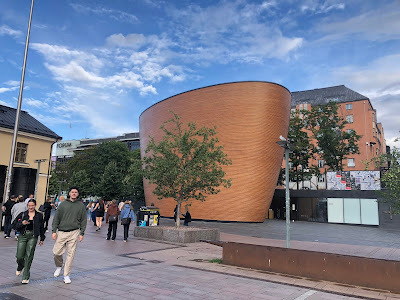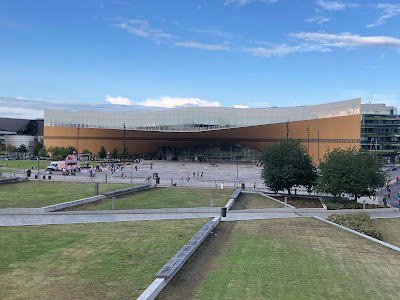The flight from Copenhagen to Helsinki was short, lasting just 1 hour and 20 minutes. I had a pleasant conversation with the young, handsome Finnish man seated next to me and learned some interesting bits of history about Finland and Helsinki from him.
Upon landing at Helsinki airport on time, I was already familiar with the efficient public transportation system, thanks to some pre-arrival research. Apple Maps showed me how to use public transit to get from the airport to the Central Station area where I was staying.
At the airport, I asked a store clerk for directions to the train station. They not only guided me but also recommended downloading the HSL app, which allows you to purchase train tickets and navigate the city's transport system.
It was a bit of a walk to reach Platform 1, accessed by an escalator to the underground station. I tried buying a ticket through the HSL app, but it didn’t work. Luckily, there was a ticket machine on the platform where I bought a paper ticket for €4. After 11 stops and a 27-minute ride, I got off the train and walked to the tram station, which was bustling with people. I took the tram for two stops and then walked to my Airbnb. Due to nearby construction, I had to take a small detour, but my host was already waiting for me at the front door.
Helsinki has an excellent public transportation system that can take you almost anywhere, but the city is also quite walkable. I walked to most of the attractions.
Restaurants and grocery stores are abundant, and when I visited in August, the weather was perfect. While there were many tourists around, Helsinki didn’t feel as crowded as cities like Dublin, probably because it’s spread out over a larger area.
Market Square is a great spot to try traditional Finnish food.
Helsinki itself is a relatively modern city, known for its modernist architecture, influenced by functionalism and designers like Alvar Aalto. The city also boasts stunning neoclassical buildings, especially around Senate Square, home to landmarks like Helsinki Cathedral, the Government Palace, and the University of Helsinki. You don’t get the old European charm here like you would in Tallinn.
As in most major cities, road construction was a common sight.
I stayed in Helsinki for 4 nights and explored a lot in 3 full days. However, I felt that two additional days would have allowed me to see even more. If time permits, I’d recommend staying for at least a week to fully explore the city. Overall, Helsinki is a bustling, modern city with beautiful architecture and plenty to see and do. One experience I missed was trying a traditional Finnish sauna—maybe next time!
Here’s a list of places I visited during my stay:
Day 1 (on foot)
Helsinki Central Station and Railway Square
Senate Square: Helsinki Cathedral (White Church) and the Old Library
Bank of Finland
Market Square and Presidential Palace
Uspenski Cathedral (Red Church)
Stockmann department store
Amos Rex museum courtyard
Kamppi Metro Station and Kamppi Chapel
Day 2 (on foot and by car)
Temppeliaukio Church (Rock Church)
Oodi Library and the Parliament House
Sibelius Monument and Monument Park
Day 3 (ferry ride from Market Square and then on foot)
Suomenlinna, an 18th-century sea fortress and UNESCO World Heritage site
--------------------------------------------------------------------------------------
Brief History of Finland
Before the early 19th century, Finland was part of the Kingdom of Sweden. However, after the Finnish War (1808–1809), Finland was ceded to Russia under the Treaty of Fredrikshamn. It then became an autonomous Grand Duchy within the Russian Empire, with Tsar Alexander I granting it significant autonomy, including its own government and laws.
In 1812, Tsar Alexander I moved Finland’s capital from Turku to Helsinki, mainly for strategic reasons, as Helsinki was closer to Russia and easier to defend. This marked the beginning of significant Russian influence on the city's development.
Under Russian rule, Helsinki was redesigned to reflect the ideals of a modern, imperial capital. Architect Carl Ludvig Engel, commissioned by the Russians, designed the city’s neoclassical center, inspired by the architecture of St. Petersburg. Senate Square, with its grand Helsinki Cathedral, Government Palace, and University of Helsinki, is a prominent example of this style.


































.jpg)

















